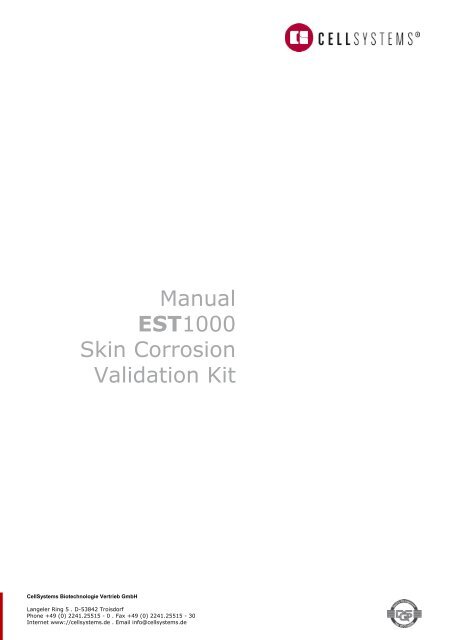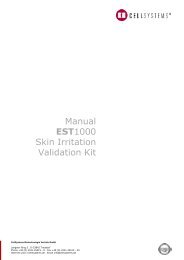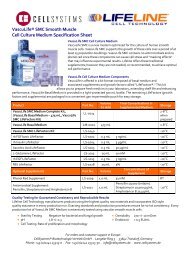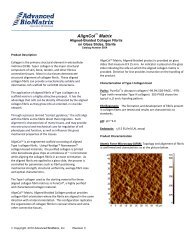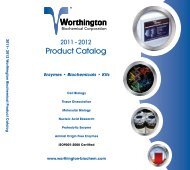Manual EST1000 Skin Corrosion Validation Kit - CellSystems ...
Manual EST1000 Skin Corrosion Validation Kit - CellSystems ...
Manual EST1000 Skin Corrosion Validation Kit - CellSystems ...
Create successful ePaper yourself
Turn your PDF publications into a flip-book with our unique Google optimized e-Paper software.
<strong>Manual</strong><br />
<strong>EST1000</strong><br />
<strong>Skin</strong> <strong>Corrosion</strong><br />
<strong>Validation</strong> <strong>Kit</strong><br />
<strong>CellSystems</strong> Biotechnologie Vertrieb GmbH<br />
Langeler Ring 5 . D-53842 Troisdorf<br />
Phone +49 (0) 2241.25515 - 0 . Fax +49 (0) 2241.25515 - 30<br />
Internet www://cellsystems.de . Email info@cellsystems.de
Table of Content<br />
1. Introduction 1<br />
2. <strong>Kit</strong> Contents 2<br />
3. Additionally Required Materials 3<br />
4. Instructions 4<br />
5. Protocol 5<br />
5.1 Application of test sample 5<br />
5.2 Addition of MTT 5<br />
5.3 Extraction of the formazan crystals 6<br />
6. Result Protocol 7<br />
<strong>EST1000</strong> <strong>Corrosion</strong> <strong>Validation</strong> V2.1b eu
1. Introduction<br />
Due to legal restrictions for animal testing, three dimensional in vitro models are<br />
increasingly used to measure effects of skin-active substances.<br />
For routine corrosion testing <strong>CellSystems</strong> ® provides the epidermis model Epidermal <strong>Skin</strong><br />
Test <strong>EST1000</strong>. The cellular structure of <strong>EST1000</strong> resembles that of natural epidermis<br />
showing a base membrane, proliferating keratinocytes and stratum corneum with an<br />
intact barrier function. It shows an excellent in vitro/in vivo comparison and allows a<br />
high reproducibility of results.<br />
<strong>CellSystems</strong> ® Epidermal <strong>Skin</strong> Test <strong>EST1000</strong> is validated for the classification of<br />
compounds concerning skin corrosion according to the OECD test guideline 431 for the<br />
testing of chemicals: “In Vitro <strong>Skin</strong> <strong>Corrosion</strong>: Human <strong>Skin</strong> Model Test”.<br />
The European Centre for the <strong>Validation</strong> of Alternative Methods (ECVAM) has published<br />
the ESAC statement on the scientific validity of <strong>EST1000</strong> method for skin corrosion<br />
testing (June, 12 th , 2009). It can be used for reliably predicting the corrosive potential of<br />
chemical substances (http://ecvam.jrc.it/ look for publications / ESAC statements).<br />
One major parameter to evaluate the skin corrosive potential of a given substance is<br />
the viability of the treated skin equivalents after exposure to the test<br />
substances. A compound is classified as corrosive if the cell viability is reduced<br />
below 50 % after 3 min of exposure. If the viability after 3 min exposure exceeds 50 %<br />
a compound is corrosive if the viability is reduced below 15 % after 1 hour. For<br />
statistical relevance 3 skin models should be used for each time point and compound.<br />
As a control PBS is used in triplicates per time point. According to the definition of skin<br />
corrosion, skin models should be incubated with the compound for 3 min and 1 h. It is<br />
crucial to evenly apply the compound on the surface of <strong>EST1000</strong>. After the indicated<br />
time skin models are rinsed thoroughly.<br />
Finally, cell viability is measured by performing a standard MTT assay. Metabolically<br />
active cells reduce the yellow tetrazolium salt MTT (3-[4,5–dimethylthiazol-2-yl]–2,5–<br />
diphenyltetrazolium bromide) to insoluble purple formazan crystals. The addition of<br />
isopropanol dissolves the crystals and the change in colour can be quantified by<br />
standard absorbance measurement. The relation between the absorbance values of the<br />
treated skin models and of the control models defines the rate of cell survival.<br />
The validation kit is designed to confirm interlaboratory reproducibility and to gain<br />
reliable results in your laboratory. It consists of 2x 18 epidermis models of the same<br />
production lot. The corrosive potential of two blinded test substances is determined in<br />
parallel at your facility and at <strong>CellSystems</strong> ® ISO certified laboratories in Germany. After<br />
successful performing this validation assay you will be certified. This certificate will prove<br />
your expertise in the use of <strong>EST1000</strong>, in the context of the OECD test guideline 431.<br />
<strong>CellSystems</strong> ® laboratory facility has implemented the Quality-Management-System and<br />
is certified according to DIN ISO 9001:2008, register number: 266714 QM08.<br />
<strong>EST1000</strong> <strong>Corrosion</strong> <strong>Validation</strong> V2.1b eu 1
2. <strong>Kit</strong> Contents<br />
One half of the material will be delivered to your laboratory; one half will be delivered<br />
to the <strong>CellSystems</strong> ®´ R&D department for parallel testing.<br />
You receive:<br />
• 18 human skin equivalents in 24 well plates,<br />
embedded in transport medium<br />
• 50 ml Maintenance Medium<br />
• 20 mg MTT-Reagent<br />
• 20 ml MTT-Assay Medium (enough medium to prepare a 1 mg/ml MTT<br />
solution as specified on the label)<br />
• Test Item A<br />
• Test Item B<br />
• Negative Control (PBS)<br />
• 3x 6-well plates<br />
• 3x 24-well plates<br />
• 1x 96-well plate<br />
Note<br />
The test items purchased are toxic and corrosive. Please, be careful while handling<br />
these compounds and establish suitable security precautions for your own safety.<br />
<strong>EST1000</strong> <strong>Corrosion</strong> <strong>Validation</strong> V2.1b eu 2
3. Additionally Required Materials<br />
• Class II biological safety cabinet<br />
• Incubator (37 °C, 5 % CO 2 , 95 % humidity)<br />
• Water bath (37 °C)<br />
• Vertical shaker<br />
• 96-well plate reader spectrophotometer<br />
• Micro-Pipettor (sterile)<br />
• Pipette tips (sterile)<br />
• Pair of tweezers (sterile)<br />
• Squeeze bottle<br />
• 250 ml beaker<br />
• 1 x PBS (Phosphate buffered saline), sterile<br />
• Isopropanol<br />
<strong>EST1000</strong> <strong>Corrosion</strong> <strong>Validation</strong> V2.1b eu 3
4. Instructions<br />
Preparation on receipt<br />
Immediately upon receipt check the kit for completeness and possible transport<br />
damages. Read the instructions completely and carefully before handling the skin<br />
equivalents as described below:<br />
• Please, inform <strong>CellSystems</strong> ® when the package has arrived and you are going to<br />
begin with the testing to ensure the same conditions.<br />
You can either call +49 (0)2241 25515- 0 or send the enclosed fax form<br />
to +49 (0)2241 25515-30.<br />
• The culture dishes with the cooled skin equivalents are in the inner transport box.<br />
• Set up the culture dishes (3x 6-well) and pipette 1000 μl cold maintenance<br />
medium (4 °C to 8 °C) into each well.<br />
• Remove the ParafilmTM from the transport plate with the skin equivalents and open<br />
the culture dish under sterile conditions.<br />
• Lift the inserts with a sterile pair of tweezers and transfer them into the prepared<br />
6-well plates filled with maintenance medium. Make sure not to transfer any agarose.<br />
• Avoid bubbles between the insert and the bottom of the culture dish by setting<br />
obliquely the insert into the culture dish.<br />
• Incubate the culture dishes at least 2 hours at 37 °C, 5 % CO 2 , 95 % humidity before<br />
performing first experiments. It is also possible to incubate overnight. In this case it is<br />
recommended to change medium before applying the test substances.<br />
• After this adaption-phase, your test substances can be applied onto the stratum<br />
corneum.<br />
<strong>EST1000</strong> <strong>Corrosion</strong> <strong>Validation</strong> V2.1b eu 4
5. Protocol<br />
5.1 Application of test sample (under sterile conditions)<br />
• Apply 50 μl each of test item A, test item B and PBS topically to the centre of the<br />
skin equivalents by using a sterile micropipette. It is crucial to evenly apply the<br />
compound on the surface of <strong>EST1000</strong>.<br />
For each incubation period three skin models are required.<br />
• Cultivate the skin models in the incubator (37 °C, 5 % CO 2 , 95 % humidity) for 3 min<br />
and 1 h, respectively.<br />
5.2 Addition of MTT<br />
• Prepare a 1.0 mg/ml solution of MTT in MTT-Assay Medium and add 300 μl of the<br />
MTT medium to 18 wells of a new 24-well plate.<br />
• Prepare a second 24-well plate as a “holding plate” with 300 μl Maintenance<br />
Medium in 18 wells.<br />
• Pick up each insert with tweezers. To remove the test substance rinse the tissue<br />
gently with 1x PBS (20 times) using a squeeze bottle. Remove excess PBS by<br />
gently shaking the insert and blotting the bottom with a piece of paper towel.<br />
• Place the insert into the prepared holding plate.<br />
• When every treated tissue has been rinsed transfer the inserts quickly into one<br />
well each of the prepared 24-well plate with the MTT-Assay Reagent.<br />
• Incubate the 24-well plate for 3 hrs (37 °C, 5 % CO 2 , 95 % humidity).<br />
<strong>EST1000</strong> <strong>Corrosion</strong> <strong>Validation</strong> V2.1b eu 5
5.3 Extraction of the formazan crystals<br />
• Pick up the insert with tweezers.<br />
• Remove excess MTT-Assay Reagent by blotting the bottom with a piece of paper<br />
towel.<br />
• Transfer the inserts to a new 24-well plate.<br />
• Add 2 ml of isopropanol directly to each insert. The insert in the well should be<br />
submerged completely.<br />
• Shake the plate for 1 hour at RT on a vertical shaker or store at 2 – 8 °C overnight.<br />
• Puncture the membrane of the inserts with a pipette tip and remove the inserts to<br />
combine the isopropanol extraction of each well.<br />
• Shake carefully on a vertical shaker for about 10 min.<br />
• Dispense duplicates of 200 μl of each sample dilution to an appropriate well of a<br />
96-well flat bottom plate.<br />
• Using a 96-well plate reader spectrophotometer read the absorbance at<br />
540 – 570 nm using acidified isopropanol as a blank.<br />
• If necessary dilute the sample extract 1:3 to 1:5 in isopropanol and repeat the<br />
photometric measurement.<br />
• Viability is calculated as follows:<br />
viability (%) = (absorbance test substance /absorbance neg. control) x 100<br />
<strong>EST1000</strong> <strong>Corrosion</strong> <strong>Validation</strong> V2.1b eu 6
6. Result Protocol<br />
Please, send a copy of this protocol to <strong>CellSystems</strong> ®<br />
Fax: +49 (0)2241 25515-30<br />
Date:<br />
Model: <strong>EST1000</strong><br />
Assay: <strong>Skin</strong> <strong>Corrosion</strong> Study<br />
Experimenter:<br />
Method: <strong>EST1000</strong> <strong>Skin</strong> <strong>Corrosion</strong> <strong>Validation</strong><br />
Device Verification:<br />
CO 2<br />
5% ±0.5<br />
Incubator Water bath Micro-Pipettes<br />
Temp<br />
37°C± 1<br />
Water reservoir<br />
check<br />
Temp<br />
37°C± 1<br />
1 ml H 2 O<br />
weight<br />
1.: 1.:<br />
50 μl H 2 O<br />
weight<br />
2.: 2.:<br />
3.: 3.:<br />
Mean<br />
SD<br />
CV %<br />
You may also provide a certificate of pipette calibration!<br />
Quality Evaluation:<br />
Remarks<br />
Macroscopic<br />
Microscopic<br />
other<br />
<strong>EST1000</strong> <strong>Corrosion</strong> <strong>Validation</strong> V2.1b eu 7
Schedule:<br />
Date<br />
Preincubation<br />
60 min exposure to<br />
test compound incl.<br />
appl. + washing<br />
3 min exposure to<br />
test compound incl.<br />
Appl. + washing<br />
MTT-Assay medium<br />
incubation<br />
Formazan extraction<br />
Start Stop Start Stop Start Stop Start Stop Start Stop<br />
Results:<br />
Mean<br />
OD 550nm<br />
Compound A<br />
3 min<br />
Compound A<br />
1 h<br />
Compound B<br />
3 min<br />
Compound B<br />
1 h<br />
PBS<br />
3 min<br />
PBS<br />
1 h<br />
Insert 1<br />
Insert 2<br />
Insert 3<br />
Mean<br />
Viability<br />
Compound A<br />
3 min<br />
Compound A<br />
1 h<br />
Compound B<br />
3 min<br />
Compound B<br />
1 h<br />
PBS<br />
3 min<br />
PBS<br />
1 h<br />
Insert 1<br />
Insert 2<br />
Insert 3<br />
Summarizing remarks:<br />
<strong>EST1000</strong> <strong>Corrosion</strong> <strong>Validation</strong> V2.1b eu 8


